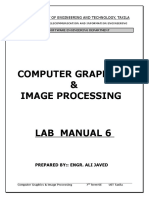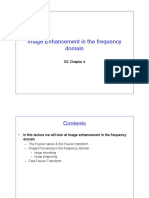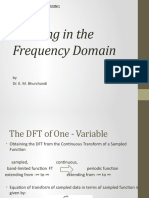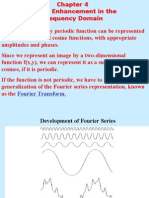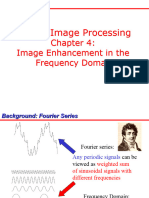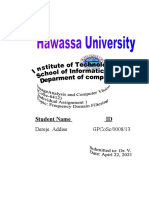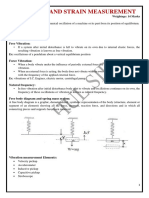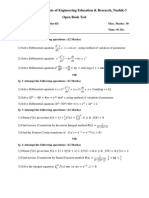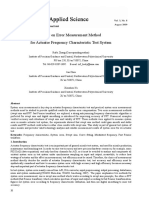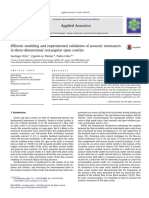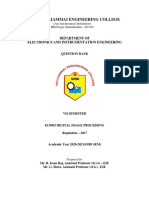Module 3
Frequency Domain
Processing
Background
Any periodic function can be expressed as the
sum of sines and/or cosines of different
frequencies, each multiplied by a different
coefficient (Fourier Series).
Even non-periodic functions can be expressed as
the integral of sines and/or cosines multiplied by
a weighting function (Fourier Transform).
The important characteristic that a function,
expressed in either a Fourier series or transform,
can be reconstructed (recovered) completely via
an inverse process, with no loss of information.
The advent of digital computers and the
"discovery" of a Fast Fourier Transform (FFT)
algorithm in the early 1960s revolutionized the
field of signal processing.
Preliminary Concepts
Complex Numbers
Fourier Series
Impulse and Sifting
Property
Fourier Transform of
One Variable
We know that FT of a rectangular function is a Sinc
function and vice versa.
Convolution
DFT of Function of Two
Variables
DFT of Function of One
Variable
DFT of Function of Two
Variables
Properties of 2-D DFT
Relationships Between
Spatial and Frequency
Intervals
Translation and
Rotation
Periodicity
The transform data in the interval from 0 to M-1
consists of two back-to-back half periods meeting at
point M/2.
For display and filtering purposes, it is more
convenient to have in this interval a complete period
of the transform in which the data are contiguous
In case of a 2-D image signal, the principle is the
same. Instead of two half periods, there are now four
quarter periods meeting at the point (M/2, N/2).
The dashed rectangles correspond to the infinite
number of periods of the 2-D DFT.
Symmetry Properties
Conjugate Symmetry
Fourier Spectrum and
Phase Angle
• Note the lack of similarity between the phase
images, in spite of the fact that the only differences
between their corresponding images is simple
translation.
• In general, visual analysis of phase angle images
2-D Convolution
Theorem
Summary of DFT
Definitions and
Expressions
Summary of DFT
Properties
Filtering in the
Frequency Domain
Frequency Domain
Filtering
Summary of Steps for
Filtering in Frequency
Domain
Image Smoothing
Introduction
Low Pass Filters – usually depict the smooth
regions, while edges and sharp intensity
transitions (like noise) contribute to high
frequencies.
Smoothing (Blurring) is achieved in Frequency
Domain by high-frequency attenuation – Low
Pass Filtering.
3 types of Lowpass filters:
Ideal (Sharpest)
Butterworth (Moderately Smooth)
Gaussian (Smoothest)
Ideal Lowpass Filter
(ILPF)
Butterworth Lowpass
Filter (BLPF)
Gaussian Lowpass
Filters (GLPF)
As seen in Table, IFT of the GLPF is also
Gaussian.
GLPFs do not exhibit ringing effect.
We notice the GLPF
profile is not as “tight”
as the BLFP one.
Due to the absence of
ringing, there are no
artifacts present – this
is needed in case of
applications like
medical imaging.
Additional Examples
of
Lowpass
Machine Filtering
Perception – Character Recognition:
Input is an image with text having poor
resolution
Characters have distorted shapes, some are
broken.
Challenge for Machines to read these
characters.
Blurring bridges the gaps in the broken
characters.
In Printing and Publishing Industry:
Used for numerous preprocessing functions like
Unsharp masking
“Cosmetic” processing
Removal of blemishes and sharp features in
facial images
In processing Satellite and Aerial Images:
Images have lines caused by natural
phenomena
Scan lines are produced in imaging equipment.
Fine detailing can be removed to improved
boundary detection for large features.
Image Sharpening
Introduction
Ideal Highpass Filter
(IHPF)
Butterworth Highpass
Filter (BHPF)
Gaussian Highpass
Filters (GHPF)
Laplacian in
Frequency Domain
Unsharp Masking and
Highboost Filtering
Homomorphic
Filtering
Selective Filtering
Bandreject and
Bandpass Filters
Notch Filters























